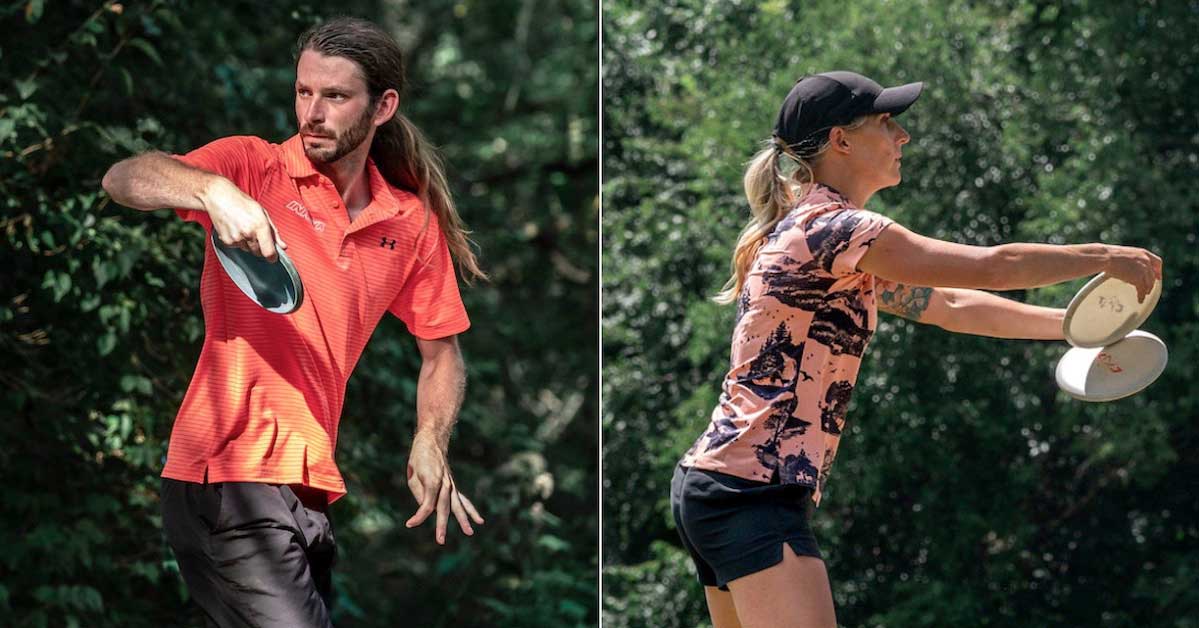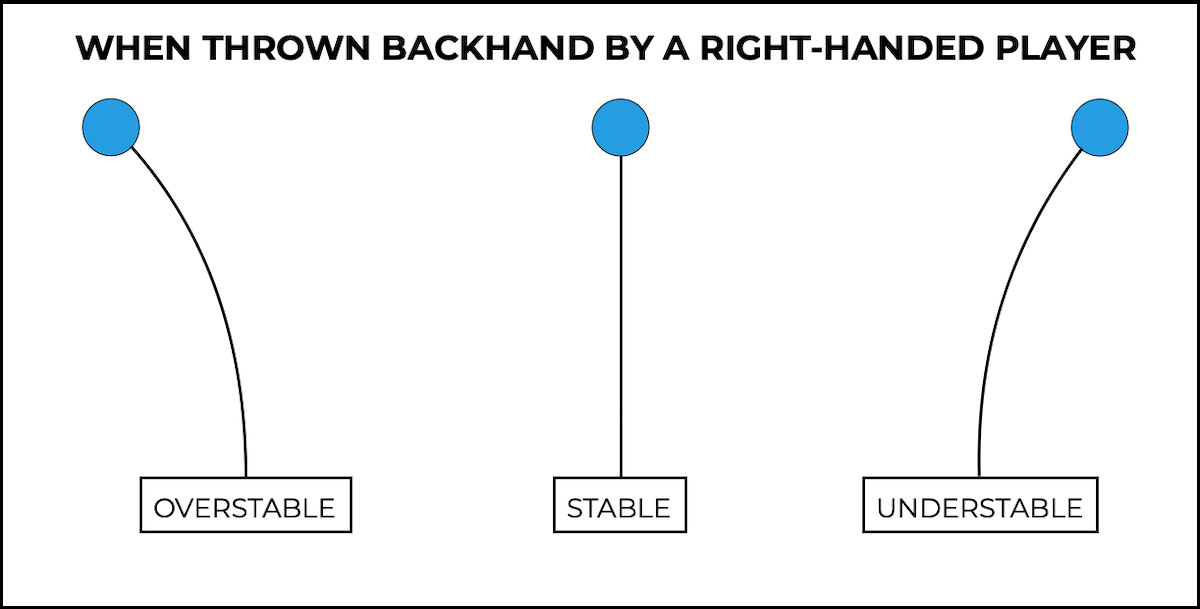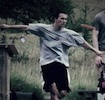
If you've ever tried to play disc golf with an everyday frisbee, you know that the experience is less than satisfying. Using discs specifically designed for disc golf is important to enjoying the sport and improving your scores.
But what sorts of discs exist and when and how should you use all of them?
Discs Explained is a series that goes over the basic disc types—putters, midranges, fairway drivers, and distance drivers—and tells you their purposes, how best to throw them, and what situations to throw them in. We also include recommendations for popular molds of each disc type.
Before We Get to Putters...
If you haven't read a different article in the Discs Explained series before, the information in this section will help you more fully understand the advice that comes later.
For those who've recently read a different Discs Explained piece, we suggest scrolling to the "Disc Golf Putters Explained" section as the information below is the same across all articles.
Focus on Righthand Backhand
Though much of the information here will still be very useful to forehand-dominant players, it's important to point out that in regards to aspects like distance, we wrote this piece specifically with backhands in mind. This is because the majority of players tend to throw backhands more comfortably than forehands.
If you don't know what we mean by backhand, it's the technique seen in this clip from JomezPro:
We hope to add similar information for forehands to the blog in the future.
Additionally, the directions we mention for flight patterns refer to those for right-handed players.
Stability and Flight Numbers

Every disc is manufactured with a specific flight pattern in mind. When thrown flat, some should go straight as an arrow (stable) while others should turn right (understable) or fade left (overstable). Discs with these intended flight patterns exist in every disc category we discuss in this series.
One way some manufacturers have attempted to concretely define the differences in discs is by using flight numbers. These are a set of four numbers that describe a disc's speed, glide, turn, and fade. We have an in-depth article discussing flight number pros and cons, but for this series it's most important to understand what's meant by "speed."
Speed, which is largely governed by shape, is the only thing that truly separates discs into the categories we explore in this series, with putters having the slowest speed numbers and distance drivers the highest.
Discs are made to follow their intended flight paths when thrown at specific speeds. If you throw a disc with too much speed (or improper technique), it will tend to turn over and sometimes even roll. If you throw a disc with too little speed, it will just fade left and not travel very far.
Unfortunately, there is no standard speed scale all manufacturers use. In this series, we'll refer to the one most widely used in disc golf that ranges from 1-15, with discs that fly true at higher speeds having higher numbers.
The maximum speed a disc can reach also affects the distance it can potentially travel. If you compared two discs whose weights were the same and whose flight numbers only differed in the speed category, the one with the higher speed rating should theoretically be capable of more distance.
Beware! You shouldn't take this to mean that because a disc is a higher speed, it will automatically fly farther. Most players need lots of practice and training to throw a high speed disc correctly. In fact, many beginners will find that slower speed discs fly farther for them than higher speed discs.
If you're interested in learning more about how disc design impacts stability, check out this article about the physics behind disc flight.
DISC GOLF PUTTERS EXPLAINED
When newer players hear that a disc is considered a “putter,” they often think it can only serve one purpose: finishing a hole at short range.
Though that’s certainly a job you want to do with a putter, you’ll find out below how disc golf putters are much more versatile than their ball golf counterparts.
Along with our own knowledge and experience, the sources for this section include 2017 Advanced Amateur Disc Golf World Champion AJ Carey and Advanced Women 2019 Amateur Disc Golf World Champion Erikah Weir. We specifically sought out amateur World Champs because top pros tend to make far different disc choices than most amateurs due to elite distance and technical ability.
What is a Putter in Disc Golf?
Putters are slow-flying, deep-rimmed, accurate discs that players use to finish holes at short distances but also to throw upshots and approaches. Most amateur players throw putters for shots maxing out at around 200 feet/61 meters but advanced and pro players use them at much longer distances.
Learn more about the characteristics of putters below.
Shape
Putters have deeper and more rounded rims than other discs. On one hand, this makes them less aerodynamic and the slowest of all discs. On the other, it makes them best at sticking in the chains of a basket. Additionally, those slow speeds mean they land more softly, allowing accurate players to place them exactly where they want without too much concern over big skips.
Flight Numbers and Patterns
When it comes to flight numbers, putter speeds range from speeds 1 to 4. But just like other types of discs, the other three flight numbers are spread all over the place. There are understable putters with higher turn numbers, overstable putters with high fade numbers, and putters with superior glide.
Generally, the putter category is known for having more of a straight flight, but discs like the Innova Pig, Westside Harp, and Discraft Zone all provide examples of putters that are significantly overstable and fade hard at the end of their flights.
Typical Distance
Fans of the pro side of the sport can name plenty of tournament moments when elite players launched a putter over 400 feet/122 meters, but for the average disc golfer, getting a putter to fly that far isn't likely.
But like we said before, one of the biggest advantages of putters is how their shape limits skip, making them the best choice for most short-range shots because they're likely to stay near the basket if you throw them there. This means even the average disc golfer should get comfortable throwing putters between 150-200 feet/46-61 meters, with more ambitious players getting up to 250 feet/76 meters or more.
How Should I Throw a Putter?
Carey suggested a specific grip for anyone tossing a putter, with slight alterations for throwing versus putting into a basket. He recommended a fan grip, meaning the middle, ring, and pinky fingers are spread out like a fan on the underside of the flight plate while the thumb sits on top of the flight plate. For putting, the pointer finger should be on the rim whereas for throwing the pointer finger should be tucked inside the rim slightly.
If you're interested in learning more about grips (including the fan grip) and putting form, we suggest you take a look at these two articles:
1. 5 Great Videos: Disc Golf Grip (Backhand)
2. 5 Great Videos: How To Putt In Disc Golf
A long run-up to most putter shots is also generally counterproductive because they aren't being thrown at high speeds. A standstill throw with a controlled throwing motion will maximize success.
“I think a common beginning error is to overpower any type of disc,” said 2019 Amateur World Champion, Erikah Weir. “This actually negates what the disc is designed to do out of your hand. A slow, deliberate release on a consistent angle will tell you more about the disc than the power you put behind it. Be gentle with yourself and know that it can take years to refine or develop a technique, and it can take just as long to break a bad habit.”
Weir said the ideal situation would be for a newer player to take a stack of different putters out to a field to see their flight path, how they react in the wind, if they skip when they land, and most importantly, how they feel in the hand.
“Throw at 40 to 50-percent power and focus on throwing the disc flat,” said Carey. “Smooth is the key.”
When Should I Throw a Putter?
“I opt to throw a putter when I need to sit soft or to shape a technical line,” said Carey. “When you need to stick soft on a green, throw a slow turnover, thread a tunnel, throw downhill, or just want to throw straight, then the putter is a good choice.”
To see a good example of what Carey meant by "sit soft," watch the clip below from JomezPro's coverage of the 2018 United States Disc Golf Championship. In it, you'll see pro player James Conrad throw a putter on a hole where throwing a higher speed disc would mean putting the shot at a higher risk of skipping into out-of-bounds water.
Carey reaches for his putter anywhere inside of 250 feet—even 350 feet if he’s throwing downhill, but there are plenty of times inside those distances when he still elects not to use it.
“I would avoid throwing a putter into a headwind, up steep hills, or when you need a lot of fade,” he advised.
In addition to approaching the basket and finishing out a hole, putters are considered great beginner discs, especially for those who have thrown a regular frisbee in the past.
“Most putters can help you learn the proper mechanics because putters fly true to your release,” said Carey. “Golf discs do not fly like frisbees, but neutral-flying putters are close.”
Popular Putters
Carey putts with a KC Aviar, a unique version of the Innova Aviar which was the third best-selling putter at Infinite Discs in 2019. Infinite Discs describes the Aviar as, “The most popular putter in the world. It is a good disc for short drives and approach shots, as well as rattling the chains.”
The two best-selling putters in 2019 were the Discmania P2 and the Axiom Envy, respectively. The P2 was designed for professionals but works well for newer players as well because it's designed to fly straight. The Envy, on the other hand, is great off the tee. Its thicker wing is described as “lid-like” and it flies very predictably at higher speeds without flipping over.
Learn About Other Disc Types
Like what you read? Read the other articles in the Discs Explained series:
Discs Explained: How & When To Throw Midranges
Discs Explained: How & When To Throw Fairway Drivers
Discs Explained: How & When To Throw Distance Drivers

